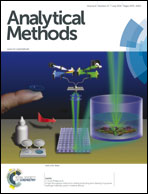Analysis of phytosterol by MALDI-TOF mass spectrometry†
Abstract
β-Sitosterol is the most abundant phytosterol lipid in plants. This study demonstrates a method for analyzing β-sitosterol using a laboratory-built MALDI-TOF mass spectrometer. The matrix compound, solvent system, laser intensity, alkali ion, and analyte concentration for sample preparation were optimized to acquire reproducible and informative mass spectra of the analyte. The best MALDI spectrum of β-sitosterol was obtained by mixing the analyte solution with an equal volume of 2,4-DHB/iPrOH–H2O (9 : 1) solution (60 mM) at 13.5 mJ cm−2 laser intensity. Under the optimized experimental conditions, β-sitosterol generated intense peaks consisting of the initial lipids and their oxidation products. The former included mass peaks at m/z 396.6, 397.6, 436.9, and 452.6, which corresponded to the [M − H2O]+, [M + H − H2O]+, [M + Na]+, and [M + K]+ ions of β-sitosterol, respectively. The latter included mass peaks at m/z 412.7, 413.7, and 431.9, which corresponded to the [M′ − H2O]+, [M′ + H − H2O]+, and [M′ + H]+ ions of mono-oxidized β-sitosterol, respectively. A quantitative analysis of β-sitosterol was also conducted using a matrix peak. Calibration curves obtained for β-sitosterol show a good linear range of three orders of magnitude with a regression coefficient square of 0.992. The linear ranges were between 12.1 and 1207.5 μM. The detection limit was 10 nM. These results demonstrate the potential application of MALDI mass spectrometry for analyzing phytosterols.


 Please wait while we load your content...
Please wait while we load your content...